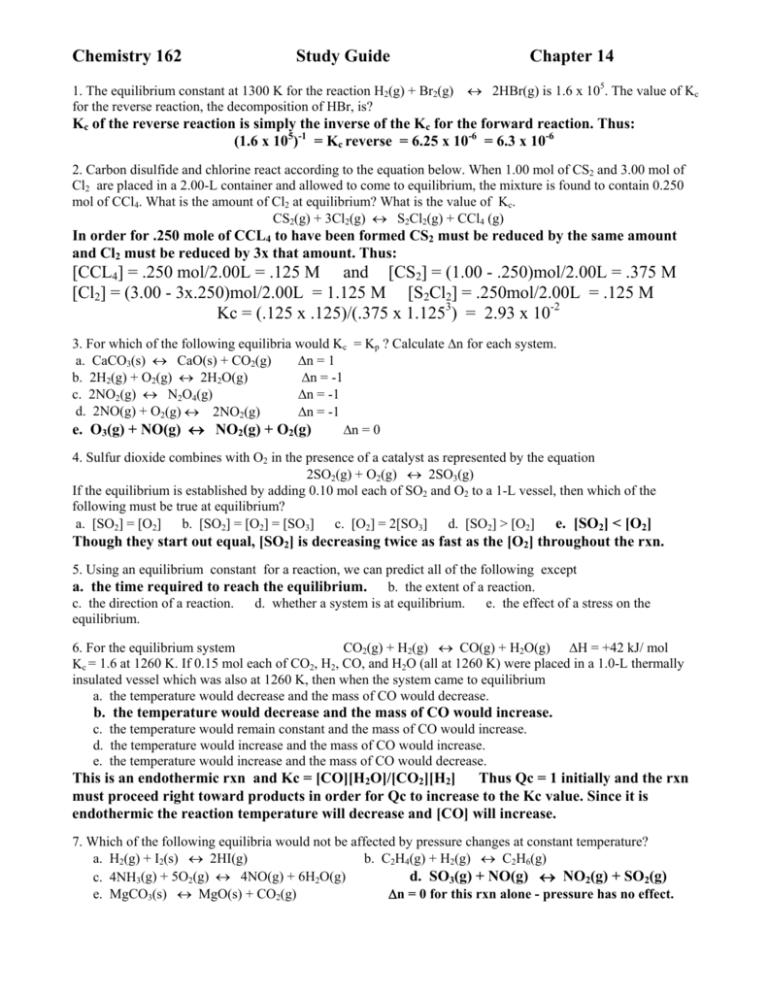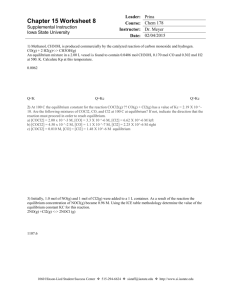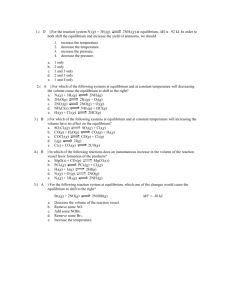Chapter 14 Key
advertisement

Chemistry 162 Study Guide 1. The equilibrium constant at 1300 K for the reaction H2(g) + Br2(g) for the reverse reaction, the decomposition of HBr, is? Chapter 14 ↔ 2HBr(g) is 1.6 x 105. The value of Kc Kc of the reverse reaction is simply the inverse of the Kc for the forward reaction. Thus: (1.6 x 105)-1 = Kc reverse = 6.25 x 10-6 = 6.3 x 10-6 2. Carbon disulfide and chlorine react according to the equation below. When 1.00 mol of CS2 and 3.00 mol of Cl2 are placed in a 2.00-L container and allowed to come to equilibrium, the mixture is found to contain 0.250 mol of CCl4. What is the amount of Cl2 at equilibrium? What is the value of Kc. CS2(g) + 3Cl2(g) ↔ S2Cl2(g) + CCl4 (g) In order for .250 mole of CCL4 to have been formed CS2 must be reduced by the same amount and Cl2 must be reduced by 3x that amount. Thus: [CCL4] = .250 mol/2.00L = .125 M and [CS2] = (1.00 - .250)mol/2.00L = .375 M [Cl2] = (3.00 - 3x.250)mol/2.00L = 1.125 M [S2Cl2] = .250mol/2.00L = .125 M Kc = (.125 x .125)/(.375 x 1.1253) = 2.93 x 10-2 3. For which of the following equilibria would Kc = Kp ? Calculate Δn for each system. a. CaCO3(s) ↔ CaO(s) + CO2(g) Δn = 1 b. 2H2(g) + O2(g) ↔ 2H2O(g) Δn = -1 c. 2NO2(g) ↔ N2O4(g) Δn = -1 d. 2NO(g) + O2(g) ↔ 2NO2(g) Δn = -1 e. O3(g) + NO(g) ↔ NO2(g) + O2(g) Δn = 0 4. Sulfur dioxide combines with O2 in the presence of a catalyst as represented by the equation 2SO2(g) + O2(g) ↔ 2SO3(g) If the equilibrium is established by adding 0.10 mol each of SO2 and O2 to a 1-L vessel, then which of the following must be true at equilibrium? e. [SO2] < [O2] a. [SO2] = [O2] b. [SO2] = [O2] = [SO3] c. [O2] = 2[SO3] d. [SO2] > [O2] Though they start out equal, [SO2] is decreasing twice as fast as the [O2] throughout the rxn. 5. Using an equilibrium constant for a reaction, we can predict all of the following except a. the time required to reach the equilibrium. b. the extent of a reaction. c. the direction of a reaction. d. whether a system is at equilibrium. e. the effect of a stress on the equilibrium. 6. For the equilibrium system CO2(g) + H2(g) ↔ CO(g) + H2O(g) ΔH = +42 kJ/ mol Kc = 1.6 at 1260 K. If 0.15 mol each of CO2, H2, CO, and H2O (all at 1260 K) were placed in a 1.0-L thermally insulated vessel which was also at 1260 K, then when the system came to equilibrium a. the temperature would decrease and the mass of CO would decrease. b. the temperature would decrease and the mass of CO would increase. c. the temperature would remain constant and the mass of CO would increase. d. the temperature would increase and the mass of CO would increase. e. the temperature would increase and the mass of CO would decrease. This is an endothermic rxn and Kc = [CO][H2O]/[CO2][H2] Thus Qc = 1 initially and the rxn must proceed right toward products in order for Qc to increase to the Kc value. Since it is endothermic the reaction temperature will decrease and [CO] will increase. 7. Which of the following equilibria would not be affected by pressure changes at constant temperature? a. H2(g) + I2(s) ↔ 2HI(g) b. C2H4(g) + H2(g) ↔ C2H6(g) d. SO3(g) + NO(g) ↔ NO2(g) + SO2(g) c. 4NH3(g) + 5O2(g) ↔ 4NO(g) + 6H2O(g) e. MgCO3(s) ↔ MgO(s) + CO2(g) Δn = 0 for this rxn alone - pressure has no effect. Chemistry 162 Study Guide Chapter 14 8. For the reaction system 2NH3(g) ↔ N2(g) + 3H2(g) at equilibrium, ΔH is 92 kJ. In order to increase the value of K for this reaction, we could (You may select more than one answer) 1. increase Temp. 2. decrease Temp. 3. increase the pressure. 4. decrease the pressure. 9. In which of the following reactions does an instantaneous decrease in the pressure of the reaction vessel favor formation of the products? b. PCl5(g) ↔ PCl3(g) + Cl2(g) c. H2(g) + I2(g) ↔ 2HI(g) a. MgO(s) + CO2(g) ↔ MgCO3(s) d. N2(g) + O2(g) ↔ 2NO(g) e. N2(g) + 3H2(g) ↔ 2NH3(g) For a system at equilibrium decreasing pressure and getting an increase in products means that formation of products increases pressure (to counteract what we did to destabilize the system) thus we are looking for a positive Δn, i.e., more moles of gases on the right than on the left. 10. 0.500 mol of NOCl is placed in a 1.00-L reaction vessel at 700 K and after the system comes to equilibrium, the concentration of NOCl is 0.440 M. Calculate the equilibrium constant Kc for the reaction: 2NOCl(g) ↔ 2NO(g) + Cl2(g) This requires and ICE chart to write a mathematical relationship for each of the equilibrium concentrations. Initial Change Equilibrium Thus, 2NOCl(g) ↔ 2NO(g) + Cl2(g) | 0.500 0.0 0.0 | -2x +2x +x | 0.500 -2x +2x +x Kc = (2 x 0.030)2 x 0.030 0.4402 Kc = [NO]2[Cl2] [NOCl]2 [NOCl] = 0.500 -2x = 0.440 2x = 0.060 x = 0.030 Kc = 5.58 x 10-4

![CHEM 1520 SI MON, TUES, & WEDNES 1.Calculate [H3O+] in a](http://s3.studylib.net/store/data/007346334_1-b78d73402f58153c92290299886ff084-300x300.png)





